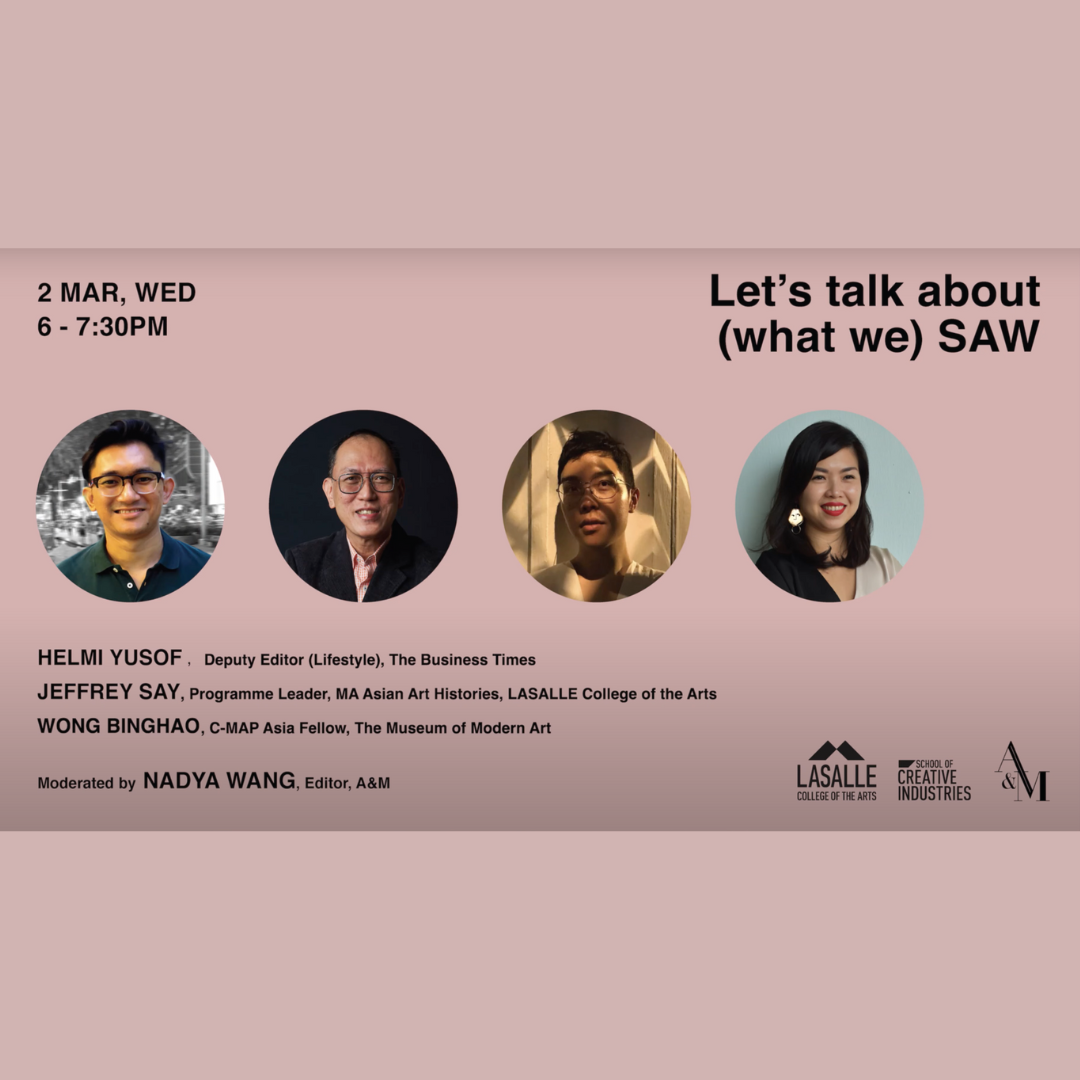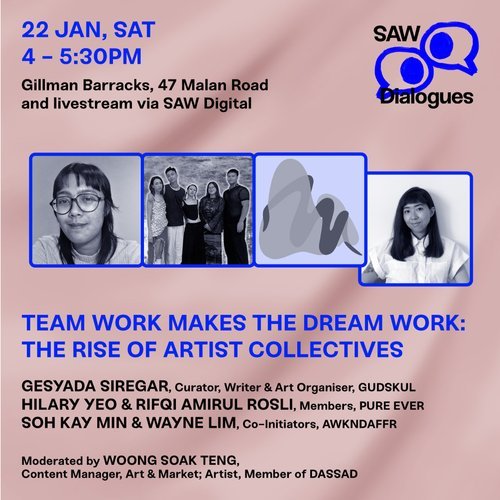Let’s talk about (what we) SAW Part 1
Helmi Yusof, Jeffrey Say, Wong Binghao and Nadya Wang
By Vivyan Yeo
Key points:
The tenth edition of SAW was enthusiastically attended by residents in Singapore. The challenge will be to strike a balance in catering to both local and international audiences as borders open.
There was increased diversity in the types of content on offer and the places they were shown. These are positive changes to be further developed.
While SAW is but one of many events on the visual art calendar in Singapore, it is a landmark one that simultaneously engenders collaborations for the rest of the year.
While there are objective indicators for a successful art week, there are also subjective ones that differ from one stakeholder to the next.
Organised by the MA Arts and Cultural Leadership programme at LASALLE College of the Arts in partnership with Art & Market, ‘Let’s talk about (what we) SAW’ is a two-part forum created in response to Singapore Art Week (SAW) 2022.
The first event saw a lively discussion about expectations in the lead-up to SAW 2022, their experiences of this special tenth edition, and what would make for an “ideal” art week. The panel featured Helmi Yusof, Deputy Editor (Lifestyle) of The Business Times; Jeffrey Say, Programme Leader of MA Asian Art Histories at LASALLE College of the Arts; and Wong Binghao, C-MAP Asia Fellow at The Museum of Modern Art. The talk was moderated by Nadya Wang, Editor at Art & Market.
Here are the takeaways from the panel:
The tenth edition of SAW was enthusiastically attended by residents in Singapore. The challenge will be to strike a balance in catering to both local and international audiences as borders open. Jeffrey pointed out that SAW coincided with the opening of Singapore Art Museum at Tanjong Pagar Distripark, which he anticipates to be the next visual arts cluster given its vibrant energy in January. Binghao noted that this was the second year that SAW occurred during the pandemic. While there was a reduction in international visitors, it was encouraging to see a robust local audience engaging with Singapore art. They also welcomed conversations with the international and local residents at the Singapore Art Museum, emphasising the need to look outwards and think about how local practitioners can respond to global socio-political issues today. Helmi wondered whether the renewed focus on Singapore art can be maintained when international borders open, given that the country has always been a cosmopolitan hub. He suggested that more collaborations between Singapore and international artists could appeal to local and global audiences in future iterations.
There was increased diversity in the types of content on offer and the places they were shown. These are positive changes to be further developed. The panelists observed that there were more intergenerational exchanges at SAW 2022. Jeffrey highlighted the shows ‘We’re Young Once’ at Art Agenda, S.E.A. and ‘Bridging Through the Age’ at Maya Gallery, which both looked at shared concerns and shifting perspectives among artists of different ages. Helmi spotlighted shows that were rooted in the history of Singapore’s art scene, including ‘Epilogue’ at Changi Fairy Point that saw current members of The Artist Village respond to the group’s history, and the solo exhibition ‘Proximities’ by artist Zulkhairi Zulkiflee, who responded to the work of pioneer Singapore artist Cheong Soo Pieng. He added that this SAW edition included a more comprehensive and interdisciplinary range of mediums and formats such as NFTs, design and graphic art, which attracted new audiences. Binghao likewise underlined that an art ecology only functions when it includes a diversity of participants working in a range of approaches. They singled out the exhibition ‘Fated Love Sky’, curated by Chand Chandramohan and Racy Lim, for its sensitive pairing of artists, collaborative nature, and process-driven approach.
On the flip side, Jeffrey reflected that more art shows could be accessible by permeating the heartland areas in Singapore. They could take up communal areas such as heartland malls and void decks, much like the show ‘Bus.Stop.Art.’ that featured art installations and interventions at bus stops as part of SAW 2021. Helmi pointed out that SAW 2022 had a significantly higher number of events in the heartlands than any past iterations. He agreed, however, that more could be done to reach audiences on a national scale. He listed ‘Open Homes’ at Singapore International Festival of the Arts (SIFA) in 2017 and projects by OH! Open House as successful examples that penetrated heartland areas.
While SAW is but one of many events on the visual art calendar in Singapore, it is a landmark one that simultaneously engenders collaborations for the rest of the year. An audience member called attention to how art weeks have historically been built around art fairs. This year, however, there were no big art fairs to anchor SAW. Binghao cited art historian Kathleen Ditzig’s article on Art Forum about how Singapore has generated its own rhythm without the presence of Art Stage in 2019. They added that Singapore is fortunate to have robust public funding for SAW 2022, which boasted a wide range of self-organised shows. When asked by an audience member about events, other than SAW and the Singapore Biennale, that inject vibrancy to the art scene, Nadya and the panelists listed the Singapore Clay festival, Light to Night Festival and SIFA.
Nadya spoke about how SAW is a catalyst for new projects to be executed, and for conversations for new collaborations to occur. On the topic of sustaining interest in the arts throughout the year, Jeffrey talked about the benefits of working organically and independently of funding from the state. He mused about the possibility of resurrecting festivals such as ‘The Future of Imagination’, spearheaded by Lee Wen in 2003. Other events that were brought up by the panelists include ‘East Side Open Studios’ by Peninsular in 2018, ‘Singapore Gallery Weekend’ by Art Galleries Association Singapore in 2020, and ‘Walk Walk Don’t Run’ by Grey Projects in 2021. Helmi elaborated on how state funding naturally comes with strings attached; ideally, art practitioners would want to create without constraints. He appreciated that this iteration of SAW was accessible to a wide variety of audiences, which could help build a patronage scene with both individuals and corporations.
While there are objective indicators for a successful art week, there are also subjective ones that differ from one stakeholder to the next. Helmi pointed out that yardsticks of success would depend on who you ask: art lovers would look at the quality of the art, galleries would seek higher sales, bureaucrats would aim to reach key performance indicators, and the general public would wish to have a good time. Binghao expressed that to them, diversity is the main indicator of success. Visitors should be able to see everything across the spectrum, which in turn allows room for discussions of different natures. They hope to see more “open-ended spaces” that encourage conversation, such as residencies and educational initiatives like the ‘External Assessment Summer School’ founded by Studio Vanessa Ban in 2018. Jeffrey stated that having fresh perspectives is an indicator for a successful art week. This year, he appreciated seeing an emergence of shows by young and innovative curators. For future iterations of SAW, Helmi and Jeffrey look forward to seeing an overarching vision to anchor the event, such that exhibitions could have more curatorial connections with one another.
Watch the full recording of ‘Let’s talk about (what we) SAW Part 1’ here:
Let’s talk about (what we) SAW Part 2 will take place next Wednesday, 9 March from 6pm to 7.30pm. Click here to find out more.














